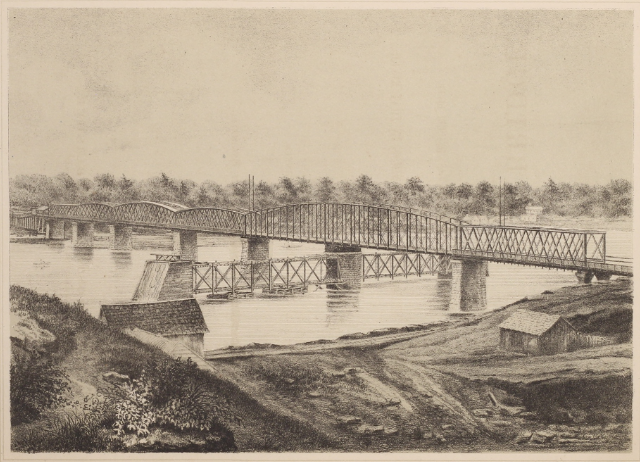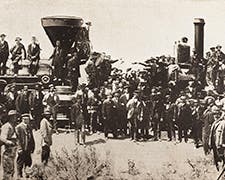Bridges and Tunnels on the Transcontinental Railroad

The Kansas City Bridge was designed by Octave Chanute, started in 1867, and completed in July 1869. A city that was considered "utterly insignificant" before the bridge was built. Kansas City became a distinguished rail center with seven railroads shortly after it was opened. Image source: Chanute, Octave, and George Shattuck Morison. The Kansas City Bridge. New York: D. Van Nostrand, 1870, frontispiece.
The successful design of bridges, trestles, and tunnels along the transcontinental route was critical for the railroad to function. Construction crews built these structures as they worked ahead of the track-layers. They crossed rivers, canyons, through mountains, and over dry gullies that would wash with water during rain and spring snowmelt. Engineers for both railroads faced dangers and endured environmental extremes on a scale that no railroad builder had yet faced.
Bridges and Trestles
Existing bridge design was incapable of supporting the stress of the heavy loads concentrated over the axles of a train. The structures also lacked the flexibility needed to traverse acute curves and abrupt changes in grade. New designs were needed to accommodate heavier and faster locomotives that would replace forms of transport like oxen and horses. Bridges designed for the transcontinental railway kept road grade at an inclination that allowed trains to ascend and descend hills at a safe rate of speed.
In the Sierra Nevada range, track raised on trestles hugged steep cliffs, making it possible to build a railroad through the mountainous Donner Pass. Trestles, one of which was eleven hundred feet long, hugged the precipitous sides of Cape Horn. In Building the Pacific Railway, author Edward Sabin describes:
Here a bed had been literally chiselled from the granite slope so sheer that laborers, yellow and white, were suspended by ropes while they hacked, drilled and blasted, 2500 feet above the rushing American River. Steadily making height, the iron trail bored on past the storied mining camps of Gold Run, Red Dog, You Bet, Little York, startling the echoes with raucous blasts of the panting iron-train, signalling civilization's advance.
Before the advent of the railroad, trusses were used in foot and wagon bridges. The design was made up of supporting members joined together into triangular forms. For the railroad, the truss bridge was reinvented and constantly improved upon, from its overall design to the design of its separate members. The truss was ideal for the transcontinental railroad because it required less lumber. Its downward thrust required fewer substantial support members than the horizontal thrust of an arch bridge would have needed. Because it was built of small members joined together it could be manufactured off-site and constructed by a relatively unskilled work force.
Both the Union Pacific and the Central Pacific railroads used William Howe's patented truss design. The Central Pacific's American River Bridge and the Union Pacific's bridge over the Missouri River, on either end of the transcontinental railroad, were examples of the use of Howe's truss. The Howe truss was the first design to incorporate metal with the wood construction. Wood was plentiful along much of the right-of-way. Howe's design made it possible for the competing railroads to build bridges and trestles quickly and out of readily available materials in order to get the trains moving and bringing in revenue. By incorporating metal into his design, Howe's invention made it possible for the railroads to build with unseasoned wood. Iron bridge members could be adjusted to accommodate the shrinkage or warping of the wood as it aged.
The railroad companies first built temporary wooden trestles and bridges that they later replaced with more durable and permanent iron structures. Wood, though prone to decay and fire, was cheaper and more obtainable than the iron (and, much later, concrete) that would replace it.
The wooden structure of the Union Pacific's Dale Creek Bridge was twice replaced, both times by iron bridges, before being made obsolete by the railroad's relocation. The bridge, built over the Dale Creek between Laramie and Cheyenne, Wyoming, was, at 600 feet, the longest bridge on the original Union Pacific route. With stone foundations and wooden supports, it raised the track 120 feet over the bottom of the ravine and required guy ropes to hold it steady in the wind.
About fifty miles northeast of Sacramento, the Central Pacific built the Dry Creek Bridge in four forty-five-and-one-half-foot wooden spans. It was the iconic rickety wooden bridge of the American Western movie, tall and narrow, with impossibly rangy and willowy-looking piers. Although trains had to reduce their speed considerably to cross a long wooden bridge or trestle, the important thing was to get the trains moving to collect revenue that would pay for new and improved bridges.
Tunnels
By the time the railroads met at Promontory Point, the Union Pacific had dug four tunnels. This accomplishment seems insignificant when compared to the fifteen tunnels dug by the Central Pacific through the seemingly insurmountable Sierra Nevada. One tunnel alone, the infamous Summit Tunnel, then known as Tunnel No. 6, was at an elevation of 7,000 feet and was the longest tunnel built, cutting through approximately 1,750 feet of solid granite.
The 1860s were a transitional time for tunneling technology, bringing new equipment and methods to a laborious process. Despite the changes, news of the Massachusetts Hoosac Tunnel project may have influenced Superintendant James H. Strobridge, in charge of Central Pacific tunneling, to make use of manual labor rather than cutting-edge machinery. The Hoosac Tunnel took nearly thirty years to complete, due both to its five mile length and to many technological difficulties, including an excavating machine that broke and became wedged in place. When engineers suggested that new steam powered drills be tried in the Summit Tunnel, Strobridge would not allow the steam engine "Sacramento" to stop hauling debris from the tunnel long enough to make the hose connections for the drills.
Instead of using steam power to dig its tunnels, the Central Pacific Railroad relied on the muscle of men wielding hammers and chisels to make the holes into which blasting powder was packed. An on-site blacksmith's shop stayed busy, employed in restoring the tips of rapidly blunted tools. At one point during the winter of 1866-67, there were eight thousand men working in three round-the-clock shifts, attacking the granite from four faces, drilling inward from the ends and outward from the center. When the black powder they used first was replaced with a new explosive, nitroglycerin, the pace of excavation increased from 1.18 to 1.82 feet per day.
The work force that chiseled through the Sierra Nevada granite was composed mainly of Chinese immigrant workers who had arrived in California during the 1850s seeking to profit from the gold rush. But few Chinese workers found their fortunes in the mines. The late 1850s and early 1860s saw the passing of numerous local and state laws that discouraged companies from hiring Chinese. Indeed, Central Pacific officials initially balked at hiring Chinese workers because of prejudiced attitudes and a feeling that their slight statures were not suited for the demanding work of building railroads. An unreliable white workforce, however, forced Strobridge's hand and he agreed to employ Chinese workers in early 1867. The replacement workers proved so capable that the stunning masonry support of a portion of the railroad was named the Chinese Wall, an artifact of the original construction that remains intact more than 150 years later.
Granite was not the only obstacle faced by the Central Pacific when building tunnels. During that winter of 1867, forty-four storms brought record snows, with a total accumulation of forty feet. The laborers lived and worked in the tight warrens of tunnels they dug in the snow and the mountaintop. At another tunnel on the Central Pacific line, the Donner Peak Tunnel, or Tunnel Number Nine, work was stopped because snow drifts reached as high as twenty feet and dangerous snow slides began exacting a toll, taking many lives. Edwin Sabin wrote of the conditions at this stage of tunnel construction, "In the spring the frozen corpses of laborers were revealed as the snow level lessened - still upright, their tools in their marble hands."
The tunnels along the Central Pacific line conquered the Sierra Nevada Mountain Range while the bridges and trestles built by the Union Pacific crossed chasms. After Theodore Judah surveyed the high mountain chain for a route for the railroad, he traveled from the West Coast to the East by taking a steamer to the Isthmus of Panama and then overland to take another steamer to New York. In the early 1860s, this convoluted route was the most efficient means of travel between the coasts of what has become the contiguous United States. The tunnels of the Central Pacific, along with the Union Pacific's trestles and bridges, opened a faster, safer route for moving freight and people over land.

